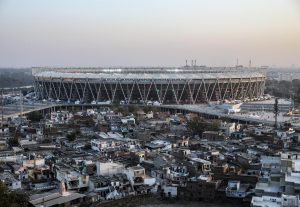There were bespoke broccoli samosas in Ahmedabad in western India; a watermelon carved with the faces of Donald Trump and Narendra Modi in Theni in southern India; sand art featuring Mr Trump and his wife Melania on Puri beach in eastern India and the “Trump collection” of specially designed gold and silver-plated tableware in Delhi in northern India. Culture and kitsch collided in spectacular fashion on all four cardinal points of the compass during Mr Trump’s 36-hour visit to India, his first as US president.
Then there was the social media commentary on Mr Trump’s visit to Mahatma Gandhi’s Sabarmati Ashram home, where the US president seemed to be working the spinning wheel so beloved of India’s independence leader. “Only thing common between Mahatma Gandhi and Donald Trump is spinning yarn,” one Twitter user said.
And finally, there was the “Namaste Trump” rally.
The drumbeat during Mr Trump’s brief passage to India was about unique, record-breaking moments and grand metrics to do with crowd size. At least 100,000 people were bussed into Ahmedabad’s Motera Stadium. Before Mr Trump took the stage, the audience was treated to the 1978 song Macho Man, and as the rally ended, it heard the Rolling Stones warn You Can’t Always Get What You Want. The Indian authorities cast the occasion as “two dynamic personalities, one momentous occasion”. It is true that once it is finished, Motera — with capacity for 110,000 spectators — will dislodge Melbourne Cricket Ground as the world’s largest cricket stadium.
Much of the talk has been of pageantry, a stonking great show made for the TV cameras or for short campaign ads to secure Mr Trump’s re-election. No one, least of all Mr Trump, pretended there was any particular substance to the visit beyond the fact that it took place. “Well, we can have a trade deal with India, but I’m really saving the big deal for later on,” Mr Trump said before embarking on the 13,000-kilometre flight to India. Accordingly, the main substantive policy announcement during Mr Trump’s visit assumed great significance. It is for the sale of $3 billion worth of US military helicopters to the Indian armed forces and Mr Trump has touted the agreement as an example of the “critical partnership” between the two countries. While it is easy to dismiss that as spin, there are elements of truth in the categorisation.
Their shared anxiety about China is palpable. This is why the US and India have expanded military exercises, upgraded trilateral relations with Japan, revived a quadrilateral dialogue that includes Australia and instituted an annual dialogue of foreign and defence ministers. Mr Trump used part of his time in Ahmedabad to call on India to help ensure “a free and open Indo-Pacific for our children and for generations to come”. As a nuclear power bent on military growth, the second-most populous nation after China, and with the world’s fifth-largest economy, India is considered the most suitable Asian counterweight to China. It is something that will matter to Mr Trump and his eventual successor in the White House, be that in the election of November 2020 or 2024.
China is probably the only foreign policy issue on which India and the US currently converge with relatively little friction. They agree that it is a geopolitical challenge, and share concerns about China’s Belt and Road Initiative and access to the South China Sea. While they diverge on the granular detail of how to counter it, there is enough to signify harmony.
Meanwhile, India and the US seem to have agreed to be discreet about escalating bilateral trade tensions even though the Trump administration has imposed tariffs on steel and aluminium from India and ended its preferential trade concessions under a tariff system that benefits products from least developed countries. And New Delhi has not offered public riposte to Mr Trump’s complaint that it is the “king” of “unacceptable” import tariffs. Washington too has spoken sotto voce, if firmly, about India’s arms purchases from Russia.
But it is the ideological convergence of Modi-led India and Trump-led America that reinforces the Indian and US administrations’ claims to the significance of the moment. It truly is the case in that the leaders of the world’s largest and oldest democracies seem so aligned on principles usually considered beyond the pale. Critics say that Mr Trump and Mr Modi are “mutual enablers in parallel assaults on democratic and religious freedoms”.
There are profound implications of this joining of hands over the seas. Even while Mr Trump was in India, clashes erupted in the capital, Delhi, over Mr Modi’s new Citizenship Amendment Act, which excludes undocumented Muslim migrants from a fast track to naturalisation. But Mr Trump continued to publicly praise Mr Modi for his unifying governance of a diverse and free India.
Of course, Mr Trump and Mr Modi lead similar movements in their respective countries, both of which are born of the political right and zealously participate in culture wars. And though they are very different by birth and upbringing — Mr Trump is the son of a rich man; Mr Modi of a tea-seller — both are showmen, handy with social media, bold in stating their views and decisive to act.
It could be argued that Mr Trump’s visit to India was significant because it was a clarifying moment. Until now, the chemistry between Modi’s India and Trump’s America could have been dismissed as creative fiction from political spin doctors. No longer.


